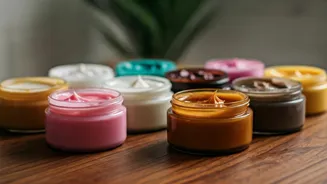Monsoon Hair's Challenge
The monsoon season's high humidity levels are the primary culprits behind common hair problems. The air is saturated with water molecules, which hair readily
absorbs. This absorption causes the hair shaft to swell, disrupting its smooth surface and leading to frizz. This reaction is particularly noticeable in those with naturally curly or wavy hair, as these hair types tend to have more irregular structures, increasing their susceptibility to moisture-induced swelling. Moreover, the increased moisture can weaken the hair's protein bonds, making it more fragile and prone to breakage. The combination of swelling and weakened structure leads to the unmanageable, frizzy appearance many experience during the monsoon. Furthermore, the scalp's condition is also affected. The increased humidity can promote excessive oil production, potentially leading to clogged pores, and contributing to issues like dandruff and hair fall. Therefore, understanding the mechanics of how monsoon conditions influence hair is the first step toward developing an effective care regimen.
Humidity and Frizz Connection
The relationship between humidity and frizzy hair is rooted in the fundamental structure of hair. Human hair is porous, meaning it absorbs moisture from the surrounding environment. When the air is humid, it means there's a high concentration of water molecules present. These water molecules penetrate the hair shaft, specifically targeting the cortex, which is the inner layer composed of protein fibers. As the water is absorbed, the hair fibers swell and the hair shaft expands. This swelling is not uniform, leading to unevenness. This irregularity disrupts the smooth cuticle, the outermost layer of the hair. When the cuticle is not smooth, light is scattered, and the hair looks frizzy and dull. The impact of humidity varies based on hair type. People with naturally curly or wavy hair often experience more frizz since their hair structure is inherently more prone to absorb moisture and disrupt the natural curl pattern. The chemical bonds within the hair's structure can also be disrupted, which enhances the susceptibility of frizz. This is the reason why proper care, including the use of hydrating products, is crucial in managing frizzy hair caused by humidity.
Hair Fall: The Monsoon Impact
The monsoon season frequently correlates with an increase in hair fall, primarily because of several factors. The first is the increased moisture, which can weaken the hair's protein structure, making it more brittle and prone to breakage. Secondly, the scalp's condition is also affected. The humid environment encourages oil production, potentially leading to clogged pores and inflammation, which can hinder healthy hair growth and promote hair fall. Furthermore, fungal and bacterial infections on the scalp can thrive in the humid conditions, exacerbating hair fall. During monsoon, people tend to wash their hair more frequently due to humidity and sweating. While maintaining cleanliness is essential, excessive washing can strip away natural oils, making the hair dry and susceptible to damage. Stress, which can also rise during changing weather conditions and lifestyle factors, can significantly contribute to hair fall. It is, therefore, critical to adopt a holistic approach to hair care that includes proper cleansing, hydration, and addressing potential underlying issues such as scalp infections.
Expert-Backed Solutions
To combat monsoon hair woes, experts suggest a multi-pronged approach. Firstly, using a gentle, sulfate-free shampoo can prevent the scalp from being stripped of its natural oils, maintaining the moisture balance. Secondly, incorporating a hydrating conditioner into your hair care routine is essential. It helps to replenish lost moisture and seal the hair cuticle, reducing frizz and breakage. Deep conditioning treatments, which can be applied weekly, are also recommended. These treatments are able to penetrate deeply into the hair shaft and repair damage. Thirdly, serums and leave-in conditioners help to provide a protective barrier against humidity, preventing moisture absorption and thereby reducing frizz. Moreover, avoid heat styling tools as much as possible, as the extra heat can damage the hair. If you need to style it, use a heat protectant. Diet also plays a huge role. The intake of foods rich in vitamins, minerals, and protein promotes healthy hair growth and strengthens the hair from the inside out. Consult a dermatologist to get personalized advice tailored to your hair type and condition.
Dermatologist's Recommendations
Dermatologists often have specific recommendations tailored to monsoon hair care. They emphasize the importance of washing hair regularly, but not excessively, to maintain a clean scalp. Choosing the right shampoo is crucial, and sulfate-free shampoos are often suggested to avoid stripping the hair of its natural oils. The use of a good conditioner after every wash is non-negotiable; it seals the hair cuticle and reduces frizz. Dermatologists may also advise on the use of hair masks or deep conditioning treatments, especially those containing hydrating ingredients like hyaluronic acid, glycerin, or natural oils, to restore moisture. Furthermore, they might suggest avoiding harsh chemical treatments such as perming or straightening during the monsoon, as these can damage the hair and exacerbate frizz. In cases of excessive hair fall, dermatologists might recommend specific treatments or medications, such as minoxidil or supplements like biotin, after evaluating the underlying cause. They also stress the significance of lifestyle factors, including a balanced diet and stress management, in promoting healthy hair during the monsoon season.




